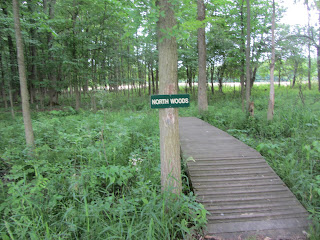Thursday,
Remi and I traveled 22 miles south of Alma to hike in part of the Maple River State Game Area just west of the village of Maple Rapids. The early morning weather was mostly sunny with a temperature of 61 degrees and no wind. Leaving the car on the dead end of a dirt road that also served as our
trail, we headed south along the bank of the Maple River where I
paused to take in this peaceful riparian landscape. On both sides of the trail, I spotted spring wildflowers including lots of white
Meadow Anemone, a few white
Virginia Waterleafs and a few purple-white
Daisy Fleabanes. Next, I saw a the blossoms of Tall
Meadow Rue. Further along, I looked up into a live Ash tree to see and hear a
Song Sparrow. On a nearby Basswood tree, I noticed the new leaves had some holes caused by the feeding of the tiny Leaf-miner
beetle. Continuing south, I heard a beautiful
bird call and soon found its source perch high in a dead, leafless ash, a colorful male
Rose-breasted Grosbeak. This bird’s sweet, robin-like song has inspired many a bird watcher to pay tribute to it. A couple of early twentieth-century naturalists said it is “so entrancingly beautiful that words cannot describe it,” and “it has been compared with the finest efforts of the robin and… the Scarlet Tanager, but it is far superior to either.” Present-day bird watchers have variously suggested it sings like a robin that has had opera training, is drunk, refined, in a hurry, or unusually happy. After turning around and
heading back, I noticed a patch of Morning Star
Sedge with its seed head that resemble a medieval spiked club. Also, close by, I could see the flower heads of
Reed Canary Grass. Approaching the car, I could barely make out a needle-thin female Blue-fronted Dancer
Damselfly resting on a Dogwood leaf. Finally, we found the
car and head back toward Alma.
Curtain opens on the month of June
Sounds of spring, creatures in tune
On the blossoms, buzz of the bees
Westerly wind rustles the leaves
On the maple, red squirrel chatters
Voices of the wild, all that matters
On the pond, green frog croaks
Cardinal calls, high in the oaks
Robin, the melody, Downy, the beat
Nature in harmony, choirs complete
D. DeGraaf




